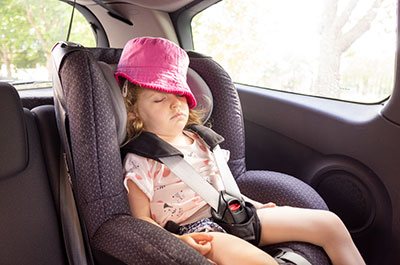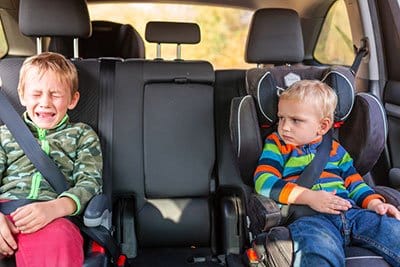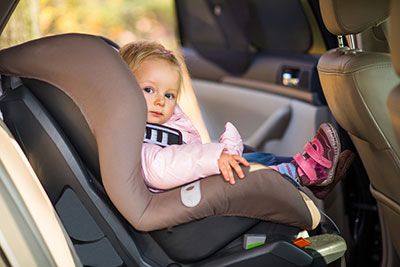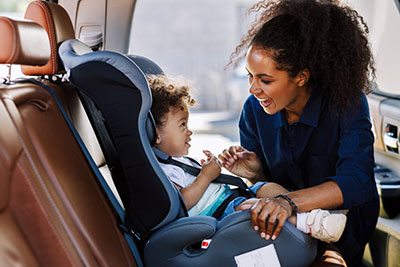Traveling with kids can be challenging, especially if it involves crossing an ocean - but proper preparation is key to making the journey easier and smoother for everyone.
If you plan on taking overseas trips in your vehicle, then one of the top priorities should be checking whether or not your car seats meet EU standards.
In this blog post, we'll provide an updated guide to help you choose the best EU-approved car seats, so your little ones stay secure during their trip across the Atlantic!
More...
Take Away Key Points:
Table of Contents
- All you need to know about European child car seats
- Are child safety laws the same for all European countries?
- What are i-size car seats?
- What are the differences between European and American car seats?
- Can you bring your child's car seat to Europe?
- What is the best solution for the child restraint system in Europe?
- FAQs
- Why are car seats different in Europe?
- Can I use an American car seat in Europe?
- Can I use a European car seat in the US?
- Can I use the Ride Safer travel vest in Europe?
- Can a 7-year-old travel without a car seat in the UK?
- Why do European car seats not have chest clips?
- Can you rent a car seat in Germany?
- Summary
All you need to know about European child car seats
If you plan on visiting Europe someday soon with your children, you need to know some rules regarding the child restraint system standards. This is crucial if you will not/cannot bring or use your American car seat inside the European Union borders.
So, let's see the European car seat requirements, compare them with the US car seat regulations, and determine whether or not you can bring your car seat to European countries.
What are European car seat laws?
Regarding car seats in Europe, standards and tests are unique, as some countries add their regulations beyond the rules set by the European Commission's ECE R129 (2013) and UN R129.
Additionally, older ECE R44/04 seats may be subject to less stringent limits, and regulations may even differ depending on where you're driving in a country.

What is the difference between the ECER129 and ECE R44.04?
The latest European Union vehicle safety regulation, ECE R129, was introduced in 2013 and improved its predecessor, ECE R44.04. The revised standard is intended to make the child restraint system easier to use, create more room for children, and ensure a better fit and increased side-impact protection.
One of the differences between these two regulations is that while ECE R44.04 was based on the child's weight, ECE R129 takes the child's height into account when selecting a child restraint system.
It is recommended to consider both your child's height and weight when looking for a car seat for the first time, with age only serving as a supplementary factor when choosing the most appropriate car seat.
European car seat regulations
Here are EU car seat regulations in Europe. Ensure you know them thoroughly to use the child's car seat correctly:
- Babies should use the rear-facing car seats until 15 months or as little as 22 pounds of weight limit in older European car seats.
- Toddlers may ride in a forward-facing car seat, but this varies by country, with some allowing a booster seat at 3 years old.
- All children under four traveling in the rear seat must use the proper child restraint.
- Older children must use a forward-facing car seat or booster seat until reaching certain heights, which depend on the country (e.g., 135 cm/53 inches in the UK and 150 cm/59 inches in Germany).
- Car seats are not usually mandatory in taxis but may be required for specific trips, like Germany and Spain.
- It is important to keep within the manufacturer's specifications when using a car seat (e.g., don't use a 4+ rated booster seat if local law only requires 3+).
- Chest clips are prohibited, except with newer R129 safety standards
- A high-back booster seat must be used for children under 125cm/49 inches and 22 kg/48 pounds of weight limits.
- Top tethers may be necessary depending on the type of car seat, and cars may have either LATCH or locking seat belts available for installation.
- It is not allowed to use the rear-facing car seat in the front passenger seat with an active airbag. The drivers will pay penalty points for rear-facing with the airbags turned on. You will get three penalty points on your driving license.
- The only exception to the rule is when you have two back seats, so you must install one in the front passenger seat, but they must have the airbag deactivated.
Are there exceptions to EU seats in the EU car seat laws?
European car seats comply with local laws to best protect children traveling within the EU regulations. But, there are certain exceptions for children when they cannot use the appropriate restraint in the vehicle seat. Let's see the exceptions to the European car seat laws:
- When using a taxi/private hire vehicle in Europe, there may not be suitable child car seats available.
- If necessary, children over 3 are allowed to use the adult seat belt in the back seat of a car without room for a child car seat.
- Children who cannot sit in the rear seats may travel in the front if an appropriate car seat for their weight/height is used.
- It is not mandatory for bus or coach trips to have child restraint systems, but if regular seatbelts are available, children aged 3-12 must use them (just like all other passengers).
Is a child car seat mandatory in taxis in Europe?
A taxi is an exception from the car seat laws, so a child car seat is not mandatory in a taxi vehicle. But, you must search for the legal requirements of many countries, as the car seat laws might differ in other countries. Some countries might be stricter in child car seats and safety laws.
Are child safety laws the same for all European countries?
EU law sets a minimum standard that all member states must meet; however, some countries have stricter regulations. Therefore, although you may generally use your car seat throughout the EU, it is important to check local car seat laws in advance to make sure you comply.
In Ireland, drivers may be penalized with points on their license if they are found to have a rear-facing car seat in the front of the vehicle without having deactivated the airbag.
Italy now requires that all cars be equipped with an integrated safety device to alert drivers if a child has been left behind inside the car seat or in the backseat.
In the UK, only EU-certified car seats are allowed, and it is strictly forbidden to use US-approved car seats.
Seat belt laws for public vehicles in Europe differ from country to country, so travelers should ensure they familiarize themselves with each nation's regulations before crossing borders.
Children over a certain height can use adult seat belts without additional car seats; however, this law also varies from country to country, so travelers should carefully review regulations before heading overseas.
Here you can check various child car seat laws for different countries.
Car seat standards in France

Children who are 10 years old or younger and those who measure less than 135cm in height must utilize a UNR44 or R129-approved child car seat when traveling in the back of a vehicle. It is not permissible for these children to occupy the front seat without using the appropriate child restraint unless no rear seats exist in the car.
For anyone aged between 135cm and 150cm tall, a booster seat can be used instead of a car seat, while babies can be placed in a rearward-facing car seat if the airbag is deactivated.
Ultimately, it is the driver's responsibility to ensure that all individuals under 18 years old are wearing a seat belt or other suitable protection device. When selecting a car seat, these should adhere to either UNR44 or R129 standards for UK roads and vehicles.
On the other hand, there is no requirement for any form of safety restraint when traveling in taxis.
Car seat standards in Spain
Children under the age of 18 or measuring less than 135 centimeters must be secured in a UNR44 or R129-approved car seat within the back seats of a vehicle.
There are exceptions to this rule in cases where a car contains only two seats or if there is not enough room for additional car seats. One car seat may be positioned on the front seat in these instances, provided that its air bag has been deactivated.
Failure to comply with these regulations may result in a fine of up to 300 euros, and police officers have the right to ask those without a proper car seat for their children to wait until somebody can bring one or until they are transported in another vehicle equipped with an appropriate restraint system.
UK car seats are allowed so long as they are certified under either UNR44 or R129 standards.
Car seat standards in Germany
Using a car seat approved to UNR44 or R129 is essential for young children who are either less than 150cm tall or under the age of 12, whichever milestone comes first.
Car seats with these approved standards must be used in taxis as well, and it's important to have other necessary items in your vehicle when driving, such as reflective jackets, headlamp beam deflectors, warning triangles, and a first aid kit.
All cars should also carry a fire extinguisher and a high-visibility vest for each passenger in case of an emergency. It is highly recommended that car seats are replaced every five years to ensure child safety.
Car seat standards in Italy
Children up to 150 cm in height must use a child car seat approved by UNR44 or R129 regulations. This rule applies regardless of the child's weight or age and applies if there are no seat belts available in the car.
As such, children under three years old cannot be transported in a vehicle where seat belts are not present. In addition, children under 150 cm are also not allowed to ride in the front seat.
Although UK car seats can be used, they must meet UNR44 or R129 standards to be accepted. No car seats are required for taxis. However, other safety items must be present when driving.
This includes reflective jackets, headlamp beam deflectors, warning triangles, a first aid kit, and a spare tire. Having these items on hand will help ensure safe motor travel for all passengers.
What are i-size car seats?
This regulation includes an extra category, i-Size, which is specially designed for child car seats compatible with the newly established European seating position standard (i-Size). This particular type of car seat offers improved safety benefits compared to car seats that follow the conventional ECE R129 standard.
Since i-Size seats have a more tailored design, they can provide higher levels of protection, enhanced comfort, and a better fit for kids of different ages. Additionally, this regulation requires any i-Size seat to come with specific features such as side impact protection, advanced headrests, and adjustable harnesses, making it easier for parents to ensure their children's safety.
What are the differences between European and American car seats?
Here are the main differences between the car seats that might help you decide better whether or not to bring domestic car seats.
LATCH vs. ISOFIX
ISOfix and LATCH are both systems for securing car seats in place, with the former being a European-based system and the latter primarily used in North America.
ISOfix utilizes rigid metal bars extending from the back of a child restraint system which locks into positions at pre-determined points within a car. This type of installation tends to be more secure than LATCH and simpler and quicker since threading any straps or belts into place is unnecessary.
However, ISOfix is often heavier and more expensive than LATCH systems, and although it provides greater stability, it is not mandatory for use in European cars.
In contrast to ISOfix's rigid design, the LATCH system uses two upper anchors connected to lower anchors by flexible webbing straps that can be tightened or loosened to secure a child's seat in place. Since the child seat installation process involves less effort and material, this option is often more cost-effective than the European child seat and safety equipment.
In the United States, a few rigid LATCH car seats are available, but most of them use flexible ISOfix (also known as ISOflex or LATCH straps). This type of child restraint system requires that the seatbelt goes through the same trajectory as it usually would before attaching to the lower anchors located in the vehicle.
Instead of simply being able to push the car seat into place like with a genuine ISOfix or rigid LATCH system, users have to take a few more steps with flexible ISOFlex/LATCH straps, thus increasing the risk of incorrect installation. ISOfix was explicitly created to reduce car seat installation errors when parents used a car seat. Unfortunately, the LATCH system doesn't tackle this issue that much.
Given its complexity and potential for error, parents need to be aware of both types of systems and their limitations to ensure their car seats are installed correctly and securely.
Forward-facing tether straps

All car seats in the United States must have a top-tether strap to meet safety requirements and pass crash tests. In Europe, though, forward-facing car seats are not mandated to have a top-tether strap, although some heavier models offer such a feature. This is because when a lap belt is used for the seat, it tends to be positioned relatively low on the car seat itself, which does not adequately prevent forward motion during an accident.
To mitigate this risk and keep the car seat from moving too far forward, American regulations require that any forward-facing car seat include a top-tether strap. This further ensures occupant safety by supplying additional child restraint and stability to the car seat during a collision.
Many European seats do not come equipped with top tether anchors, and traditional European car seats are designed to rely on the shoulder portion of a three-point seatbelt.
This means that European crash tests are conducted using a three-point seat belt to simulate a real-life crash scenario, while US tests typically use a lap-only seat belt.
The shoulder belt employed in the European seatbelt system helps prevent the child's forward movement during an accident and holds the top part of the car seat back firmly against the vehicle's body.
Through this method, any excessive force generated by an impact can be redistributed along more secure points within the vehicle, preventing serious injury or even death among occupants.
Chest clips
European car seats do not feature chest clips due to the European regulation that requires children to be able to be removed from their seats in one single motion. This means having both a crotch buckle and a chest clip would violate the regulation.
Another justification for avoiding the use of chest clips in European car seats is in case of an emergency. Emergency services are accustomed to removing children from a child seat with just one motion, and having to interact with an extra piece of hardware like a chest clip might slow them down.
Furthermore, research has shown that chest clips can be inadvertently closed too tightly, potentially leading to injury or constriction of the child's abdominal tissue. Therefore, it is best for users of European car seats when in Europe not to add chest clips for these reasons.
The government does not mandate the use of chest clips on American car seat models and instead may be seen as a cultural legacy. This is because the clips were originally introduced to address situations in which parents did not properly tighten the straps on car seats.
In response to this issue, manufacturers of American car seats began adding chest clips, which consumers perceived as a safety feature and demanded in greater numbers. Consequently, all car seat manufacturers now include these clips in their American models to meet customer requirements.
Although research has not determined whether chest clips provide any additional safety benefits, it is important to note that they are included as part of crash testing processes conducted on American car seats. Therefore, it is recommended that parents do not remove them from their child restraint systems.
Locking seatbelts vs. friction
The pre-crash locking system used in European child restraint systems provides friction-based stability that holds the car seat in its position during everyday driving or in the initial moments before the seat belt is automatically retracted and locked.
This ensures that when the belt is tightened, it won't have to deal with additional slack, allowing it to be secured in its optimal position. As a result of this feature, the car seat will be more securely held onto during an accident, thereby providing greater protection for the child occupant.
American and Australian car seats typically do not rely on friction to keep them in place. Instead, they have straightforward seatbelt paths on the child restraint systems that minimize friction.
These child restraint systems may lock into place with an in-built locking mechanism, be switched from the Emergency Locking Retractor (ELR) to the Automatic Locking Retractor (ALR), or use a locking clip on the seat belt near the latch plate.
Both methods are safe for pre-crash locking and stability when used correctly according to their respective standards, as demonstrated through research and study of crash test data.
Can you bring your child's car seat to Europe?
Bringing an American car seat to Europe is an option. It will physically fit, though a seat belt locking clip may be required. However, European Commission law requires that only European car seats or UN-certified car seats are used in the region, with no worldwide certifications available yet.
Renting a car seat can be risky; for example, a rear-facing car seat is not common practice beyond 15-18 months. It can also get expensive if traveling to different parts of Europe and renting a child car seat.
Public transportation can work well in big cities like London and Paris, but taking a taxi or car service from far-flung airports is often necessary. When using taxis, it is unsafe to have an unsecured child or use an adult seat belt before they are old enough (varies by country). The best option is if a car service provides appropriate-age car seats.
For exploring areas such as Tuscany, Switzerland, and Croatia by car, finding suitable rental vehicles with age-appropriate European car seats could be challenging when arriving in an unfamiliar destination as there may not always be any available.
Using a non-EU-certified car seat in Europe is technically illegal but unlikely to cause any issues unless noted on the police report following an accident. Insurance might also become problematic, although this has yet to happen in reality.
What is the best solution for the child restraint system in Europe?
Everyone's decision on the great Europe car seat debate will be different. But, safety features are non-negotiable. Bringing an American car seat every time may not be the correct or most convenient legal choice. However, the US car seat might be your safest option.
You should bring your car seat manual and follow the manufacturer's instructions when flying with your children and child restraint systems. The flight attendants will check the correct car seat installation on the airplane seat. In addition, the EU standards will allow child restraint systems approved and manufactured within the EU borders and countries outside their borders. You can find more information HERE.
It would be best if you strived to abide by (or exceed) local child seat laws regarding car seats, to avoid further complications. Additionally, you might bring your car seats on all flights to ensure added safety and security of them arriving undamaged. As you plan your trip to Europe, this information can help you choose what is best for your family.
FAQs
Why are car seats different in Europe?
Car seats are different in Europe as they don't offer chest clips and use ISOFIX instead of the LATCH system. In addition, the car seat models might not use the top-tether straps and come with the friction-stability instead of locking seat belts.
Can I use an American car seat in Europe?

Legally, you cannot use your US car seat in Europe, as the car seat doesn't comply with European car seat regulations. On the other hand, you can not legally use the European seat in the US when it doesn't meet the FMVSS 213 standards.
Can I use a European car seat in the US?
No, you cannot legally use the European car seat within the US borders.
Can I use the Ride Safer travel vest in Europe?
Yes, you can use the Ride Safer travel vest in Europe. Unfortunately, this child restraint type cannot be sold in Europe. However, you can use it with or without the booster car seat within European borders as long as the stay in the country is not extended beyond six to twelve months.
Again, the law varies from one country to another, so you should refer to each country separately to find the best solution.
Can a 7-year-old travel without a car seat in the UK?
No, a seven-year-old cannot travel without a car seat in the UK. All children must be in the correct child restraint until they are twelve years old or 135 cm tall, whichever comes first. Then, they can use the seat belt.
Why do European car seats not have chest clips?
European child restraint systems require that the child can be removed from the car seat single-handedly. Therefore, having both a chest clip and crotch buckle would breach European child restraint regulations. For this reason, European car seat models don't use chest clips.
Can you rent a car seat in Germany?
Yes, you can rent a car seat in Germany and use it while traveling across the country. You can visit their official website here and find all the specific items the rental company offers.
Summary
Children cannot interchange the EU and USA child restraints, as the laws vary in safety standards, but the good news is that parents can always rent correct child restraints for their children.
Ensure the child safety systems follow the EU and UN safety laws to use the seat across the continent. And check each law about EU-approved car seats in advance to avoid further complications.
